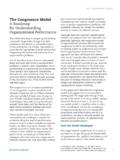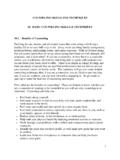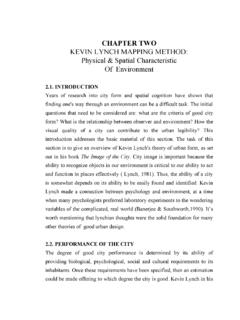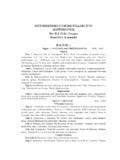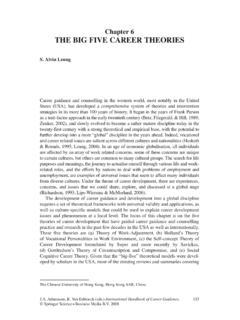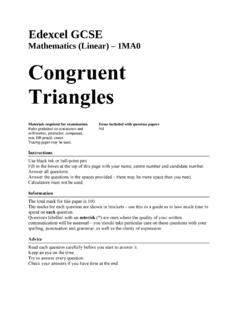Transcription of 9 Congruence and Therapeutic Presence - Shari Geller
1 148 CONGRUENCEC ongruence and Therapeutic PresenceLeslie S. GreenbergandShari M. Geller9 Congruence is probably the most complex of Rogers three therapist offeredconditions, yet the least explicated. As Rogers developed his ideas, he came tosee genuineness as the most basic of the conditions (Rogers and Sanford, 1984)Possibly because of it s later emergence as a central element, it has not received asmuch attention as the other conditions, particularly empathy. We will discuss theconcept of Congruence and suggest that to be clearly understood, congruenceneeds to be seen as being a process embedded in an appropriate network of beliefsand intentions. We will in addition suggest that it is this tacit framework of intentionsand beliefs that informs the therapist in how to be skillful in communicatingcongruently.
2 We will also review the concept of Presence and discuss it s relation tocongruence, suggesting that Therapeutic Presence be viewed as an encompassingconcept that acts as a pre-condition to Congruence and possibly as a pre-conditionto Therapeutic effectiveness in humanistic therapies in the three therapist offered conditions, Congruence often has been the mosttroublesome to the general disciplines of psychology and psychiatry. It has beenmisinterpreted either as being a license for the therapist to openly express all of hisor her feelings or needs in an undisciplined manner, or has been viewed as acondoning what psychodynamic therapists would view as negative counter-transference. In the sixties and seventies being authentic, self-disclosing andencountering, often was proclaimed as central to good therapy by a number ofhumanistic therapists without much further specification of what authentic meantor how it was Therapeutic therapists (Schutz 1970).
3 This rightfully led to the concernamong many that unbridled openness could be destructive. Thesemisunderstandings of what is meant by Therapeutic Congruence require theclarification of this concept and an explication of some of its underlying (1993) pointed out that Congruence or authenticity can, at an initiallevel of analysis, be broken into two separate components. These are 1) The abilityto be aware of one s own internal experience, and 2) transparency, the willingnessto communicate to the other person what is going on within. Rogers (1961), inusing the notion of being real with other people, appeared to emphasize bothdimensions. By being congruent he meant not only being aware of one s own149 Congruence AND Therapeutic Presence internal experience but also of sharing it with the other.
4 Thus Congruence clearlyhas two components an internal component involving awareness of one sown flow of experience and transparency, an outer component, that refers toexplicit communication. It is with this latter component of openness and honestythat much of the controversy around Congruence has claim that being transparent is Therapeutic requires, in our view, thespecification of the set of preconditions and beliefs, intentions and attitudes thatare needed for this aspect of Congruence to be Therapeutic . To simply teach youngor novice therapists that they should be congruently transparent is not alwayshelpful. This is because being transparent presumes a certain level of personaldevelopment and certain intellectual and value commitments.
5 Congruence thusdoes not stand alone as a Therapeutic ingredient. In our view, therapeuticcongruence, as well as involving awareness and transparency, also requires thatthe therapists internal experience arises out of attitudes, beliefs and intentionsrelated to doing no harm to clients and to facilitate their development. This isthe psychotherapeutic equivalent of a Hippocratic Person Centered therapy Congruence has always been seen as being a partof a triad of Therapeutic attitudes along with empathy and unconditional positiveregard. In dialogical Gestalt therapy, the emphasis on therapists genuineness orauthenticity is based on Buber s (1958) I-Thou relationship in which a genuinemeeting of client and therapist involves, among other things, the therapist spresence and non-exploitiveness.
6 The Rogerian attitudes of a willingness tounderstand the client and the prizing of a client s experience, and Gestalt notionsof Presence and non-exploitiveness, all entail intentions that are necessary forcongruence to be Therapeutic . To be facilitatively congruent, therapists thus needto be committed to understanding and respecting their clients. They need tooperate both with a genuine desire not to have power over their clients and witha belief in the Therapeutic importance of accepting their clients experience asvalid. Finally they need to be fully present and in contact with their clients aswell as themselves. These intentions both precede being facilitatively congruentand are themselves important aspects of Therapeutic of congruenceOne of the major purposes of Congruence in psychotherapy is to help establishtrust.
7 As Rogers said, when we are real with each other, this facilitates trust andcommunication (Rogers 1961). But of course, being real is in and of itself verycomplex and needs further clarification. In a post modern era, in whichconstructivist notions highlight how much is either psychologically or sociallyconstructed (Neimeyer and Mahoney, 1995), notions of what is real become one s real self, for example, has always been a problematic idea because itimplies there is such an entity as a real self, rather than seeing that the self is aprocess of construction (Greenberg and van Balen, 1998; Whelton and Greenberg,2000). Being congruent, however, when seen as a process of awareness andopenness in the moment, escapes the problem of claiming some greaterontological validity for certain aspects of self.
8 Being real in facilitative relationshipthus implies that the therapist does not hide relevant feelings and thoughts and150 CONGRUENCEat particular times communicates certain present and persistent feelings orthoughts in certain ways to help build trust and openness in the dyad. This,however, is not done manipulatively or strategically. Rather it is done from thetherapist s experience in the moment of a genuine desire to help. It is importantto emphasize that the doing aspect of Congruence involves an expressive intentionrather than a goal oriented , like empathy, (cf. Bohart and Greenberg, 1997, Greenberg andRosenberg, 2000) is not a unitary phenomenon. Rather it includes a variety ofintentions, beliefs and attitudes and manifests in a variety of experiences andbehaviours that differ at different times.
9 We need to recognize that althoughcongruence is a holistic concept, it refers, in therapy, to a complex, multifaceted,phenomenon that is embedded in a network of attitudes, beliefs and intentionsthat results in doing different things at different I am being congruent, as well as being open to my experience, I amalso doing different things at different times depending on the person I am with,the situation and the specific in-therapy context in which I am being congruent(cf. Wyatt 2000). Being present or fully attuned to the moment is a necessaryguide, both to being open to my own experience and to knowing how to respondto the unique interplay of person, situation and context. Different situations callforth different congruent actions.
10 These can, and need to be, specified further ifwe are to clearly understand what is meant by Therapeutic example, being congruent may involve the therapist saying what she isfeeling in her body at the time. It may involve speaking of a feeling that has beenpersisting over time, and actually is not being felt at the moment, in any visceralway. Or being congruent may involve the therapist saying something thatspontaneously captures her sense of the moment. Also, the current or generalfeelings being expressed congruently may range from compassion to anger, fromthreat to joy, and depending on which feeling is being felt, it will be expressed in avery specific way with it s own expressive intentions. Anger, for example, may beexpressed in order to set boundaries and to assist in resolving the feeling of beingwronged; compassion may be expressed in order to share it and to comfort; fear isprobably often expressed in order to inform the other of one s reaction to him or addition to disclosing what one is feeling, being congruent may involvesaying what one is thinking, disclosing an image, sharing a past experience ofone s own, or commenting on the interaction between persons.
